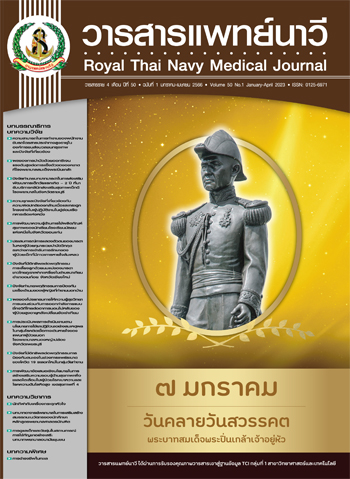Factors Influencing the Protective Behaviors against COVID-19 Pandemic Resurgence in Working-age Population
Main Article Content
Abstract
The study explored protective behaviors against COVID-19 pandemic and associated factors that influence these behaviors against the resurgence of COVID-19 pandemic in working-age population. Participants were full-time workers between the ages of 20 - 65 years who had never been infected with COVID-19. The data collection was conducted using questionnaire via Google Forms between July and August 2021. Three experts evaluated the instruments' validity with an item objective congruence (IOC) of 0.9 - 1. The reliability was tested and obtained a value of 0.60 - 0.84. Data were analyzed using stepwise multiple regression analysis. The result showed that good protective behaviors against COVID-19 pandemic resurgence were at a high level (Mean = 27.72, SD = 2.37). Facemasks were used whenever they were outside of their home (97.10%), followed by washing their hands with soap or alcohol gel (91.60%), while registering all their visits to public venues was the least common practice (47.60%). Receiving health information support, accessing health services, health policy, and receiving social support were positively correlated with protective behaviors during COVID-19 pandemic resurgence (r = .105, .139, .130, .118 and .226, respectively). The factors that could co-predict at 6.5% (R2 = .065, p < .001) included having access to health services (β = .066, p < .001) and support from families, friends, communities, and medical personnel (β = .304, p = .020). The findings of this study can be used to promote protective behaviors against COVID-19, particularly access to health services and getting social support such as health care services, family, friends, policy, etc.
Article Details

This work is licensed under a Creative Commons Attribution-NonCommercial-NoDerivatives 4.0 International License.
References
World Health Organization. WHO coronavirus (COVID-19) dashboard. [Internet]. [cited 2021 October 18]. Available from: https://covid19.who.int/.
Department of disease control. Situation of Coronavirus disease 2019 (COVID-19): pulblic health measures and problems, obstracles, prevention and control of diseases in travelers. [Internet]. [cited 2021 August 30]. Available from: https://ddc.moph.go.th/uploads/files/20174202108200 25238.pdf. (in Thai).
Center for COVID-19 Situation Administration. Coronavirus 2019 situation. [Internet]. [cited 2021 April 20]. Available from: https://media.thaigov.go.th/uploads/public_img/source/200464.pdf. (in Thai).
Bashirian S, Jenabi E, Khazaei S, Barati M, Karimi-Shahanjarini A, Zareian S, et al. Factors associated with preventive behaviours of COVID-19 among hospital staff in Iran in 2020: an application of the protection motivation theory. J Hosp Infect 2020;105(3):430-3.
Shahnazi H, Ahmadi-Livani M, Pahlavanzadeh B, Rajabi A, Hamrah MS, Charkazi A. Assessing preventive health behaviors from COVID-19: a cross sectional study with health belief model in Golestan Province, Northern of Iran. Infect Dis Poverty 2020;9(157):91-9.
Mahmood S, Hussain T, Mahmood F, Ahmad M, Majeed A, Beg BM, et al. Attitude, perception, and knowledge of COVID-19 among general public in Pakistan. Front Public Health 2020;8:1-8.
Al-Rasheed M. Protective behavior against COVID-19 among the public in Kuwait: an examination of the protection motivation theory, trust in government, and sociodemographic factors. Soc Work Public Health 2020;35(7):546-56.
Liu L, Xie J, Li K, Ji S. Exploring how media influence preventive behavior and excessive preventive intention during the COVID-19 pandemic in China. Int J Environ Res Public Health 2020;17(21):7990.
Zickfeld JH, Schubert TW, Herting AK, Grahe J, Faasse K. Correlates of health-protective behavior during the initial days of the COVID-19 outbreak in Norway. Front Psychol 2020;11:564083.
Poonaklom P, Rungram V, Abthaisong P, Piralam B. Factors associated with preventive behaviors towards Coronavirus disease (COVID-19) among adults in Kalasin province, Thailand. OSIR 2020;13(3):78-89.
Waehayi H. Severity perception and preventive behavior on the Coronavirus disease -2019 among Youth at Sateng-Nok subdistrict, Muang district, Yala province. Academic Journal of Community Public Health 2020;6(4):158-68. (in Thai).
Yaemsuda T, Suwannaka Y. Relationships between knowledge, perceived severity, perceived self-efficacy, and transmission prevention behaviors of COVID-19 of personnel, North Bangkok University. Royal Thai Navy Medical Journal 2022;49(3):615-29. (in Thai).
Phuangprayong K. The situation of impact, support needs and adaptation of working age population during the COVID-19 pandemic: empirical study in Bangkok. Suthiparithat Journal 2021;35(1):266-86. (in Thai).
World Health Organization. Coronavirus disease (COVID-19) advice for the public. [Internet]. [cited 2021 April 20]. Available from: https://www.who.int/emergencies/diseases/novel-corona virus-2019/advice-for-public.
Centers for Disease Control and Prevention. Morbidity and mortality weekly report. [Internet]. [cited 2021 April 20]. Available from: https://www.cdc.gov/mmwr/volumes/69/wr/ pdfs/mm69515 2a8-H.pdf.
Monod M, Blenkinsop A, Xi X, Hebert D, Bershan S, Tietze S, et al. Age groups that sustain resurging COVID-19 epidemics in the United States. Science 2021;371(1336):eabe8372.
Madewell ZJ, Yang Y, Longini IM, Halloran ME, Dean NE. Household transmission of SARS-CoV-2: a systematic review and meta-analysis. JAMA Netw Open 2020;3(12):e2031756.
Centers for Disease Control and Prevention. Productive aging and work 2015. [Internet]. [cited 2023 January 24]. Available from: https://www.cdc.gov/niosh/topics/productiveaging/dataandstatistics. html.
Green LW, Kreuter MW. Health program planning: an educational and ecological approach. 4th ed. New York: McGraw-Hill; 2005.
Bloom BS, Madaus GF, Hastings JT. Handbook on formative and summative evaluation of student learning. New York: McGraw–Hill; 1971.
Bartz AE. Basics Statistical Concepts. 4th ed. New Jersey: Prentice Hall; 1999.
Ongarj P, Ungcharoen R. Self-protection behavior of COVID-19: a case study of Students at Kasetsart University, Chalermphrakiat Campus, Sakon Nakhon province. P H Policy & Law 2021;7(1):87-102. (in Thai).
Deesua A, Kaewpan W, Kalampakorn S, Sillabutra J. Factors associated with preventive behaviors of work related COVID-19 among aging taxi drivers in Bangkok. Royal Thai Navy Medical Journal 2022;49(2):369-84. (in Thai).
Morasakul B, Punthasee P. Knowledge and prevention behaviors regarding COVID-19 among the first-year nursing students of Saint Theresa International College and Saint Louis College. Regional Health Promotion Center 9 Journal 2021;15(37):179-95. (in Thai).
Lüdecke D, Von Dem Knesebeck O. Protective behavior in course of the COVID-19 outbreak: Survey results from Germany. Front Public Health 2020;8:572561.


